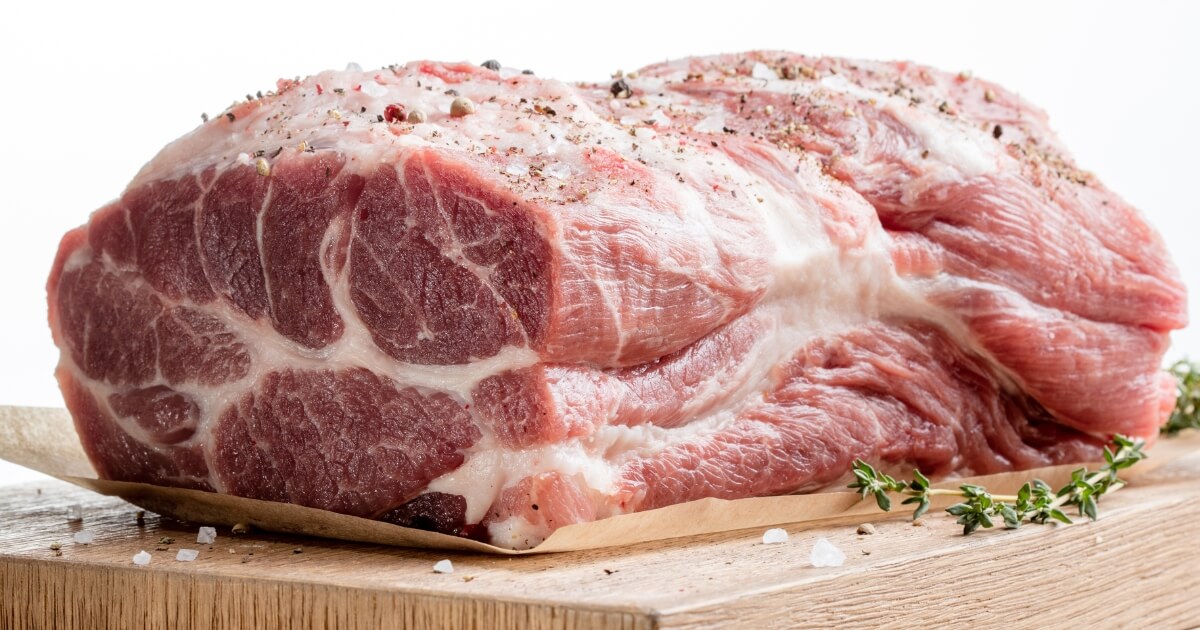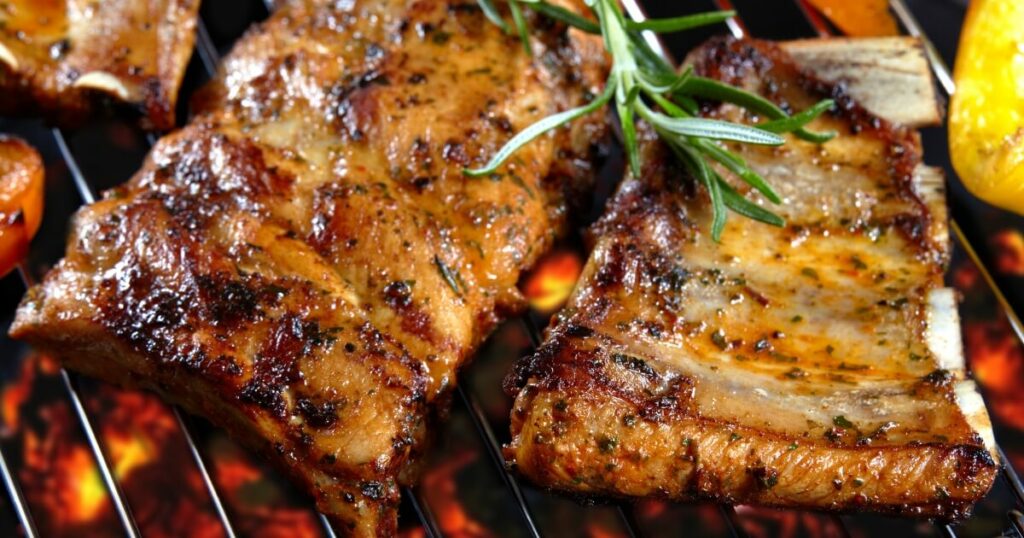I grew up eating pork multiple times a week, and more often than not, it wasn’t the best experience. But many cuts of pork are fairly cheap, widely available, and can be tasty when prepared right.
Dry pork chops with inedible fat? Yuck! Okay, it wasn’t all bad because bacon has always been good any day of the week.

Over the years, I’ve learned how to make it something to look forward to, so I wrote this handy guide to help you with all things pork! Let’s go!
Popular Pork Cuts
You know how a chicken has its wings, thighs, and breasts? Well, pork’s got its own lineup of cuts, too. Each cut offers something special, from the lean tenderloin to the marbled pork belly.
Each cut has its own cooking method sweet spot, so knowing your cuts can really elevate your pork game.
- Pork Chops: The dinner table classic, great for grilling.
- Tenderloin: Lean and tender, perfect for quick cooking.
- Pork Belly: Rich and fatty, the base for bacon.
- Ribs: Baby back or spare, they’re a BBQ favorite.
- Ham: Cured or fresh, it’s a holiday staple.
- Shoulder: Ideal for slow cooking. Think pulled pork.
- Loin Roast: A larger cut that’s great for feeding a crowd.
- Processed Cold Cuts: Often made of a mix of cuts great for sandwiches or with crackers and cheese.
- Sausages: Italian sausages on a fresh bun? Yes, please!
There are also heritage breeds like Berkshire and Duroc that are gaining popularity for their distinct flavors. But these aren’t your average supermarket pork and may be difficult to find in your area.

How To Select Pork Cuts
When you’re standing in front of that meat counter, the first thing to look for are signs of spoilage and color. A fresh cut of pork should have a nice pink hue, not too pale, and definitely not dull and gray.
Those little white flecks in the meat are fat marbling. While not as pronounced as beef, they still mean flavor and juiciness. So don’t shy away from a bit of fat because it’s where much of the taste lives.
Packaging is another thing to consider. Make sure it’s tightly sealed with no punctures or leaks. Any liquid in the package should be minimal and clear, not cloudy.
Check the sell-by date! Fresh is best, so aim to buy pork that’s well within its sell-by window. This ensures you’re getting a cut that hasn’t been sitting around for too long.
Seasonality
Pork is one of those versatile meats that doesn’t play hard to get. You’ll find it in markets and on menus all year long, making it a go-to for any season.

However, some cuts do have their moments in the sun, literally. Pork chops and ribs often become the stars of summer BBQs, gracing many grills when the weather’s warm.
But let’s not forget about the colder months. Cuts like pork shoulder become the soul-warming base for stews and slow-cooked dishes when the temperature drops.
So, while there’s no “best” season for pork, its various cuts make it a standout choice any time of year. You may only notice a price difference when demand is higher, so buying in bulk when it’s on sale may be the way to go.
How To Store Pork
Alright, you’ve got your perfect pork cut, now what?
First things first, if you’re not cooking it right away, put your pork in the fridge. Keep it in its original packaging and then in a plastic bag to catch any leaks to avoid cross-contamination.
You should never leave pork sitting out!
Temperature is key here. Your fridge should be set at or below 40°F to keep your pork fresh. Any warmer and you’re inviting bacteria to thrive and making it unsafe to consume, even after cooking.
If you’re thinking long-term, the freezer is your friend. Wrap your pork tightly in plastic wrap, followed by aluminum foil, or in a Ziploc bag to lock in quality. Make sure to label it with the date so you know when it’s time to use it or lose it.
Freezing keeps pork safe indefinitely, but aim to cook it within 6 months for the best flavor and texture. After that, eating may still be safe, but the quality will take a hit.
How To Cook Pork
Whether you’re grilling, roasting, or slow-cooking, there’s a perfect way to bring out the best in your pork. Here are a few of my suggestions:
- Grilling (Best for: Pork Chops, Ribs, Tenderloin) – Grilling is a very quick and flavorful way to cook leaner cuts. With a good marinade and a hot grill, you’ll have a tasty meal in no time.
- Roasting (Best for: Loin Roast, Ham, Tenderloin) – Roasting is a hands-off method that lets the oven do the work. It’s great for larger cuts that you want to cook evenly and keep juicy.
- Slow Cooking (Best for: Shoulder, Ribs) – Slow cooking is your go-to for cuts that benefit from long, low-heat cooking. Think pulled pork sandwiches or fall-off-the-bone ribs.
- Pan-Frying (Best for: Pork Chops, Ground Pork) – Pan-frying is quick and easy, making it ideal for weeknight dinners. It’s especially good for ground pork dishes like meatballs or burgers. And my favorite is re-heating leftover pork roast in a pan to give every bite delicious crispy edges.
Pork Temperature Guide
When cooking pork, hitting the right internal temperature is vital for flavor and safety. A good reliable meat thermometer is your best friend here, helping you ensure that each cut reaches its safe minimum internal temperature.
Aim for a minimum internal temperature of 145°F for most whole cuts and 160°F for ground pork and organs (USDA).
Recommended Internal Temperatures (Minimums)
- Pork Chops: 145°F
- Tenderloin: 145°F
- Pork Belly: 160°F
- Ribs: 145°F
- Ham: 145°F (fresh), 140°F (pre-cooked)
- Pulled Pork Shoulder: 195°F
- Loin Roast: 145°F
- Ground Pork And Organs: 160°F
You’ll notice ground pork and organ meats must hit 160°F, a bit higher than most other cuts. That’s because their surface area is much greater, allowing bacteria to thrive in more places. So a higher cooking temp is needed for safety.
After cooking, always let your pork rest for a few minutes. This makes the meat juicier and allows the internal temperature to rise a bit more, adding an extra layer of safety.
What Goes With Pork
Pork is like that friend who gets along with everyone. It pairs well with a wide range of side dishes and sauces.
To get you started, here are some of my suggestions for your next pork dish:
- Classic Sides (Best with: Pork Chops, Roasts, Ribs) – Mashed potatoes and green beans are the tried-and-true sidekicks to many a pork dish. They offer a comforting balance to the meat’s richness.
- Fresh and Light (Best with: Tenderloin, Grilled Chops) – For something on the lighter side, think salads or steamed veggies. They add a fresh contrast to the meat, making the meal feel well-rounded.
- Sauces and Condiments (Best with: All Cuts) – Apple sauce is a classic, but don’t stop there. Mustard-based sauces or a tangy BBQ sauce can elevate your pork and add a bit of moisture.
- Unexpected Pairings (Best with: Pork Belly, Ground Pork) – Feeling adventurous? Try pairing pork with fruit-based salsas or even a splash of balsamic reduction.
Whether you stick to the classics or venture into new territory, the right side or sauce can make your pork dish truly unforgettable in the best way possible.
Pork FAQs
What animal does pork come from?
Pork comes from domestic pigs. It’s one of the most commonly consumed meats worldwide. Various cuts and preparations come from this versatile animal, from bacon to ham.
Is it okay to cook pork medium?
Yes, cooking whole pork cuts to medium is safe as long as it reaches an internal temperature of 145°F. Always use a meat thermometer to be sure. Let it rest for a few minutes after cooking to allow the temperature to rise a bit more. However, offal, organ meats, and ground pork products must be cooked to a minimum internal temp of 160°F to be safe.
Is pork easier to digest than beef?
Pork and beef have similar protein structures, so their digestibility is quite comparable. However, pork tends to be leaner than some cuts of beef. The fat content in your specific cut can affect how easy it is to digest.











